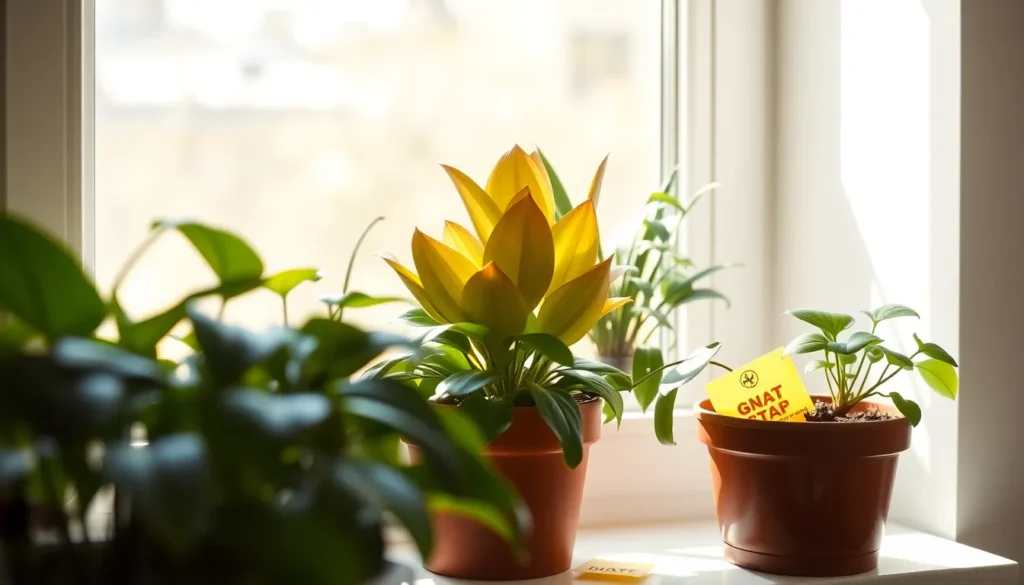Those tiny flying pests buzzing around your beloved houseplants aren’t just annoying—they’re threatening your green sanctuary. Fungus gnats might seem harmless, but these persistent little invaders can quickly multiply and damage your plant’s root system while turning your peaceful home into a frustrating battleground.
We’ve all been there: you’re enjoying your morning coffee when you notice those pesky gnats swarming around your favorite pothos or fiddle leaf fig. The good news? You don’t have to surrender your indoor garden to these unwelcome guests. With the right strategies and consistent action, you can eliminate gnats from your houseplants and prevent them from coming back.
Getting rid of gnats requires understanding why they’re attracted to your plants in the first place and implementing targeted answers that work. From natural remedies using household items to proven prevention techniques, we’ll walk you through effective methods that protect both your plants and your sanity.
Identify the Type of Gnats in Your House Plants
Knowing which type of gnat you’re dealing with makes all the difference in choosing the right elimination method. We’ll help you distinguish between the most common types found around houseplants.
Fungus Gnats vs. Fruit Flies
Fungus gnats are the dark colored pests you’ll typically find hovering around your plant’s soil surface. These tiny insects measure about 1/8 inch long and have long legs with clear or grayish wings. Their larvae live in moist potting soil where they feed on organic matter and plant roots.
Fruit flies appear more yellowish or tan in color and tend to be slightly smaller than fungus gnats. They’re attracted to overripe fruit, sugary substances, and fermented materials rather than soil. You’ll notice fruit flies congregating around kitchen areas, garbage disposals, and fruit bowls instead of your plant containers.
Body shape provides another clear distinction between these pests. Fungus gnats have a more mosquito like appearance with longer antennae and legs. Fruit flies display a rounder, more compact body structure with shorter appendages and red eyes that are easily visible.
Signs of Gnat Infestation in Potted Plants
Adult gnats flying around your plants represent the most obvious sign of an active infestation. These insects typically emerge from the soil when you water your plants or disturb the potting medium. You’ll see them hovering near the soil surface or crawling on plant leaves.
Tiny white or transparent larvae in your plant’s soil indicate a more serious problem developing below the surface. These small worms move through the top inch of moist soil and can be spotted when you gently move the soil around with your finger. Large populations of larvae will damage plant roots and stunt growth.
Yellowing or wilting plant leaves often signal that gnat larvae are feeding on your plant’s root system. Plants may appear droopy or stressed even when adequately watered. Seedlings and young plants show the most dramatic symptoms since their root systems can’t withstand as much damage.
Fungal growth on soil surfaces creates ideal breeding conditions for more gnats to develop. You might notice white mold or fuzzy growth on top of consistently moist potting soil. This organic matter provides food for gnat larvae and encourages female gnats to lay more eggs in your containers.
Remove Excess Moisture From Your Plant’s Soil
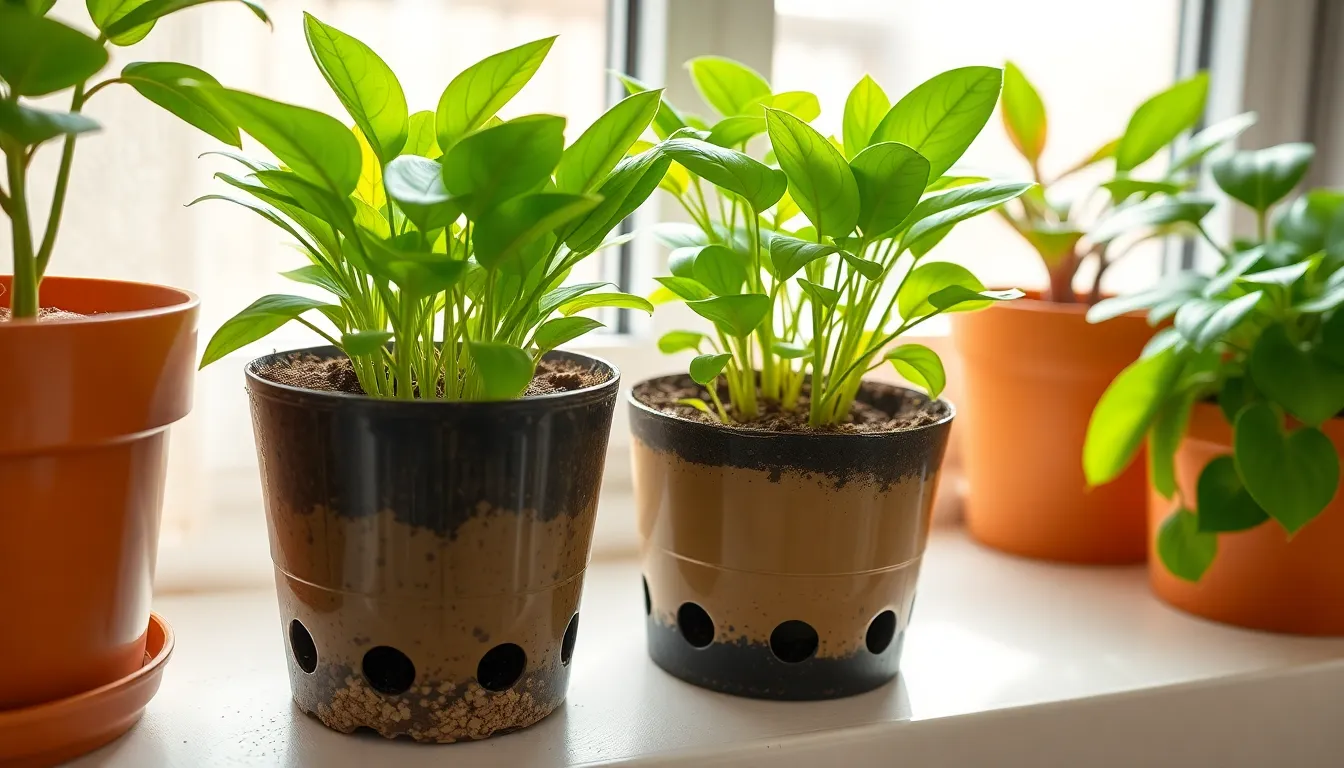
Overwatering creates the perfect breeding ground for fungus gnats, making moisture control our most powerful weapon against these persistent pests. Research shows that moist soil provides ideal conditions for gnat larvae to thrive and multiply rapidly.
Allow Soil to Dry Between Waterings
Wait for the top 2 centimeters of soil to dry completely before watering your plants again. This drying period disrupts the gnat lifecycle by making the environment inhospitable for egg laying and larvae survival.
Check soil moisture with your finger rather than following a strict watering schedule. Different plants and environmental conditions affect how quickly soil dries, so we need to adjust our watering frequency accordingly.
Turn over the soil surface occasionally to expose deeper layers to air circulation. This technique helps accelerate the drying process while simultaneously exposing any hidden larvae to air, which can kill them naturally.
Space out watering sessions longer than usual during active gnat infestations. Fungus gnats cannot complete their lifecycle in consistently dry soil, so extended dry periods effectively break their reproductive cycle.
Improve Drainage in Plant Containers
Choose pots with adequate drainage holes to prevent water from pooling at the bottom. Standing water creates soggy soil conditions that gnats find irresistible for breeding purposes.
Use well draining soil mixes that contain perlite, coarse sand, or bark chips to improve water flow. These amendments prevent soil from staying waterlogged and create less favorable conditions for gnat development.
Add a layer of coarse material like small stones or broken pottery at the bottom of containers before adding soil. This drainage layer helps excess water flow away from plant roots and soil surface areas.
Elevate plant containers slightly using pot feet or saucers with drainage ridges. This elevation allows air to circulate under pots and prevents water from sitting in contact with drainage holes.
Apply Natural Gnat Control Methods
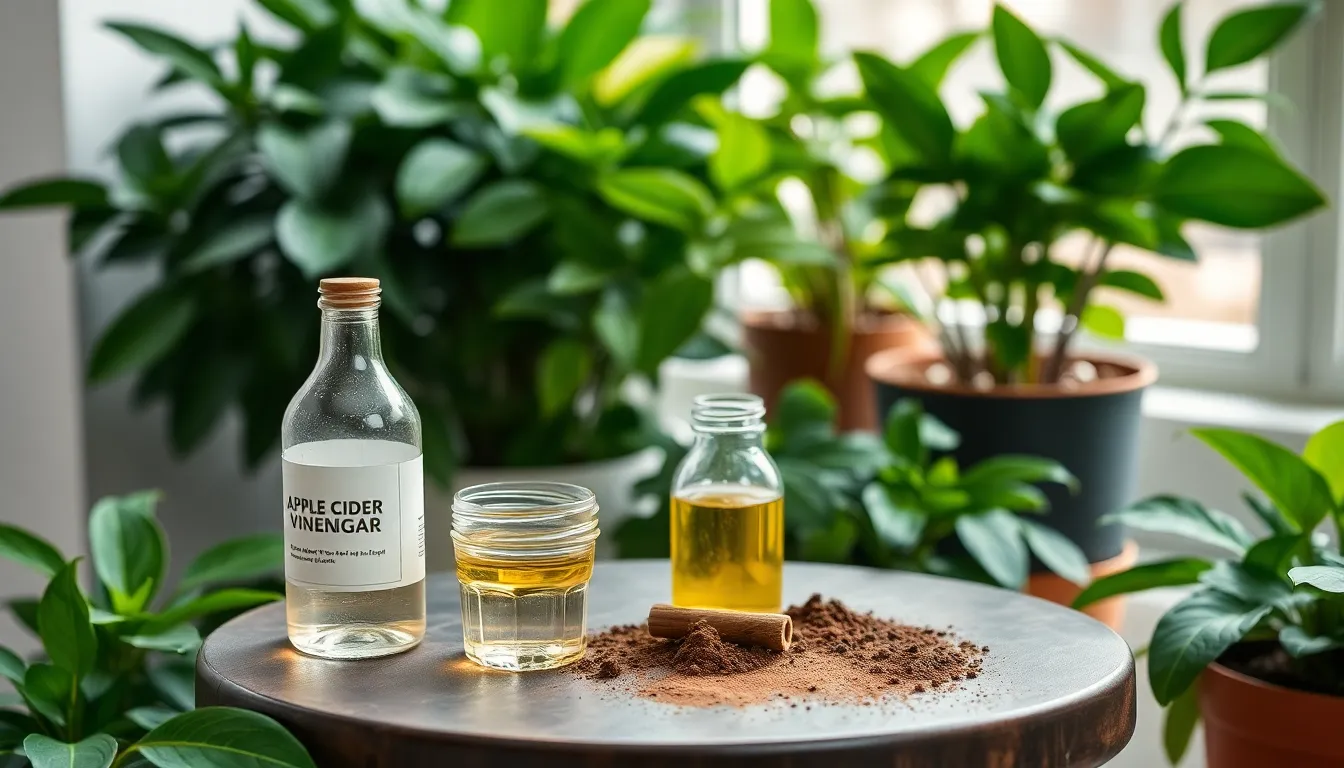
Now that we’ve addressed moisture control, we can carry out targeted natural remedies that effectively eliminate both adult gnats and their soil-dwelling larvae.
Use Apple Cider Vinegar Traps
Apple cider vinegar traps offer one of the most effective methods for catching adult gnats flying around our houseplants. We simply fill small containers with apple cider vinegar and place them near affected plants to attract and trap these pests. The sweet scent draws gnats away from our plants, where they become trapped in the vinegar solution.
Setting up multiple traps around heavily infested areas maximizes our success rate. We can enhance trap effectiveness by adding a drop of dish soap to break the surface tension, ensuring gnats can’t escape once they land on the liquid. These traps work continuously, reducing the adult population that would otherwise lay eggs in our plant soil.
Create Soap and Water Answers
Soap and water answers provide direct contact killing power against both adult gnats and larvae in our plant containers. We mix mild liquid soap with water to create a spray that suffocates gnats on contact while remaining safe for our plants. This method targets pests immediately without introducing harsh chemicals into our indoor environment.
Applying the solution directly to plant leaves and soil surfaces eliminates gnats wherever they’re hiding. We spray thoroughly but avoid oversaturating delicate foliage, focusing on areas where we’ve observed gnat activity. Regular applications every few days help maintain control as new gnats emerge from the soil.
Sprinkle Cinnamon on Soil Surface
Cinnamon acts as a natural fungicide that eliminates the fungus gnats depend on for survival, making it one of our most powerful allies. We sprinkle pure cinnamon powder across the entire soil surface to create an inhospitable environment for gnat larvae. This method disrupts their life cycle by removing their primary food source rather than just killing individual pests.
Reapplying cinnamon regularly ensures continuous protection as we water our plants and the powder settles into the soil. The antifungal properties work beneath the surface to eliminate the moisture-loving fungi that attract gnats to our houseplants initially. We use pure cinnamon rather than blended spices for maximum effectiveness against these persistent pests.
Try Physical Removal Techniques
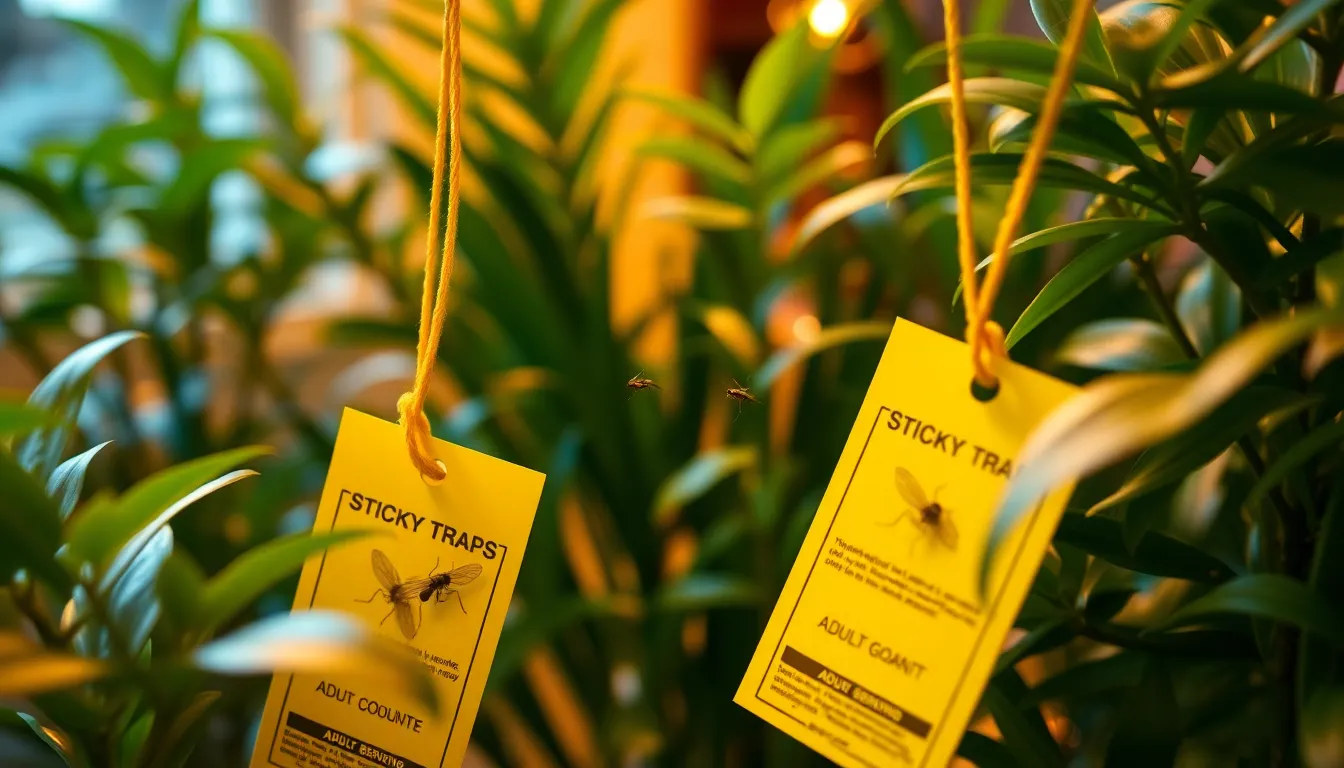
Beyond natural remedies, we can take direct action to eliminate gnats through targeted physical methods. These approaches work immediately to reduce adult gnat populations while disrupting their breeding cycle.
Install Yellow Sticky Traps Near Plants
Yellow sticky traps offer one of the most effective ways to catch adult gnats flying around our houseplants. We should place these traps close to affected plants since the bright yellow color naturally attracts flying gnats and prevents them from reproducing.
Installing traps requires minimal effort but delivers maximum results. We can position them directly in the soil or hang them near plant foliage where adult gnats tend to hover. The sticky surface captures gnats on contact, making this method particularly useful for monitoring infestation levels.
Green sticky traps designed specifically for indoor plants provide an alternative option that many gardeners prefer. These specialized traps blend better with plant aesthetics while maintaining the same effectiveness as traditional yellow versions.
Use a Vacuum to Remove Adult Gnats
A handheld vacuum becomes our immediate weapon against adult gnats swarming around plants. We can quickly reduce the adult population by targeting gnats in flight, especially during their most active periods.
Operating the vacuum requires gentle movements around plant areas to avoid damaging delicate foliage. We should focus on areas where gnats congregate most heavily, typically near the soil surface and around plant stems. This method works best when combined with other elimination strategies.
Regular vacuuming sessions help maintain control over emerging adult populations. We can schedule these removal sessions during peak gnat activity times, usually in the morning or when we disturb the soil during watering routines.
Repot Plants With Fresh, Quality Soil
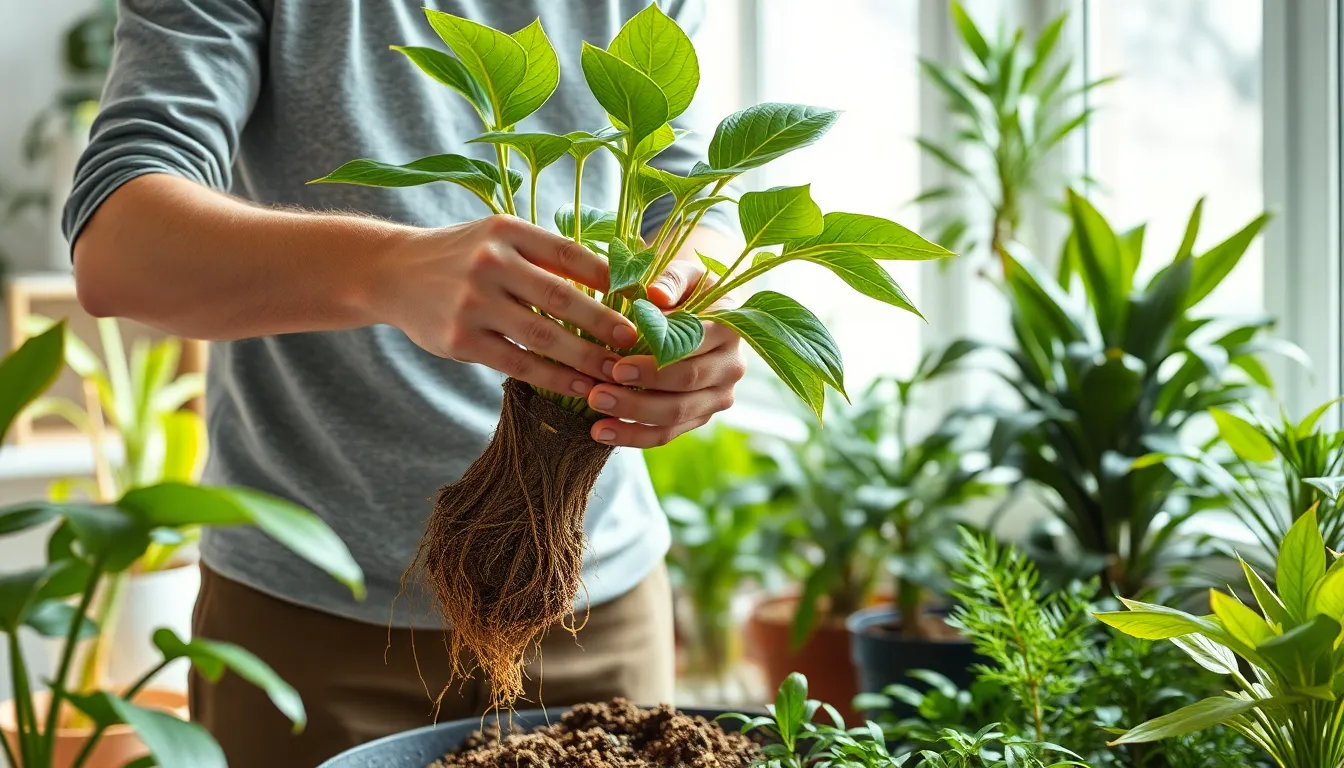
Repotting infected plants with fresh soil eliminates existing larvae and eggs while giving your plants a healthy foundation to recover.
Choose Well-Draining Potting Mix
Select a sterile potting mix that drains excess water quickly to prevent future gnat infestations. Quality potting mixes contain perlite, vermiculite, or coarse sand that creates air pockets and allows water to flow through easily rather than pooling around roots.
Avoid dense garden soil or potting mixes that retain too much moisture, as these create perfect breeding conditions for fungus gnats. We recommend choosing commercial potting mixes labeled as “well-draining” or mixing your own by adding 20-30% perlite to standard potting soil.
Check that containers have adequate drainage holes before adding your new soil mix. Plants sitting in waterlogged soil will quickly attract gnats again, even with the best potting mix.
Clean Plant Roots Before Repotting
Remove your plant carefully from its current pot and gently shake off all the old soil from the root system. This step eliminates any hidden larvae or eggs clinging to the roots that could restart the infestation cycle.
Rinse roots under lukewarm water to wash away remaining soil particles and inspect for any signs of damage from gnat larvae feeding. Look for brown, mushy, or damaged root sections that may need trimming with clean scissors.
Allow roots to air dry for 10-15 minutes before placing them in the fresh potting mix. This brief drying period helps prevent transplant shock and gives you time to prepare the new container with proper drainage materials.
Inspect the root system thoroughly for white, healthy roots versus dark or slimy damaged areas. Healthy plants recover faster from repotting and resist future gnat problems more effectively.
Implement Biological Control Solutions
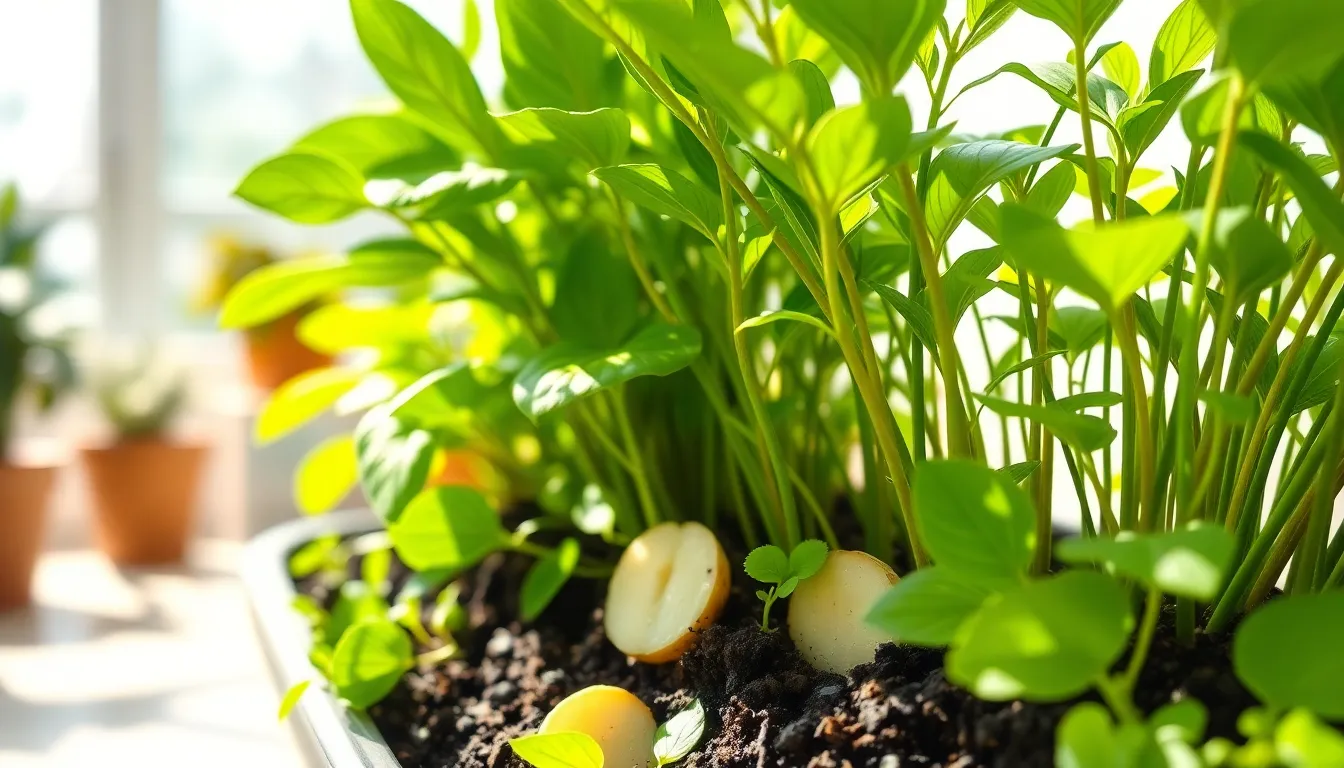
Biological controls offer our most effective and environmentally friendly approach to eliminating fungus gnats in houseplants. These natural methods target gnat larvae directly while maintaining soil health and plant safety.
Introduce Beneficial Nematodes to Soil
Beneficial nematodes provide our most powerful biological weapon against fungus gnat larvae. These microscopic roundworms, specifically Steinernema feltiae, actively hunt and destroy gnat larvae in the soil. We apply them as a soil drench, allowing the nematodes to penetrate the growing medium and locate their prey.
Nematodes work by entering gnat larvae through natural body openings. Once inside, they release bacteria that digest the larvae from within, killing them within three to four days. This targeted approach eliminates the problem at its source without affecting our plants or beneficial soil organisms.
Application requires mixing the nematodes with water according to package directions. We thoroughly drench the soil surface, ensuring the solution penetrates deep enough to reach larvae feeding zones. The treatment remains effective for several weeks, providing ongoing protection as nematodes continue to reproduce and hunt.
Use Bacillus Thuringiensis (BTI) Treatments
Bacillus thuringiensis israelensis offers our most reliable bacterial control for fungus gnat larvae. This naturally occurring soil bacterium specifically targets gnat larvae while remaining completely safe for plants, pets, and humans. We apply BTI products directly to the soil surface with enough water to ensure proper penetration.
BTI works exclusively on larvae, requiring repeated applications for complete control. Since adult gnats continue laying eggs throughout their lifecycle, we need to apply treatments every 5 to 7 days until the infestation ends. This schedule ensures we catch new hatchlings before they mature into egg laying adults.
Products containing BTI come in various forms including liquid concentrates and granules. We choose the format that best suits our application needs, ensuring thorough coverage of the soil surface. The bacterium produces toxins that specifically target gnat larvae digestive systems, providing effective elimination without environmental concerns.
Detection methods help us monitor treatment effectiveness. We can insert raw potato slices into the soil, which attract larvae within a few days. This simple technique helps us track remaining populations and determine when our biological control efforts have succeeded.
Apply Commercial Gnat Control Products
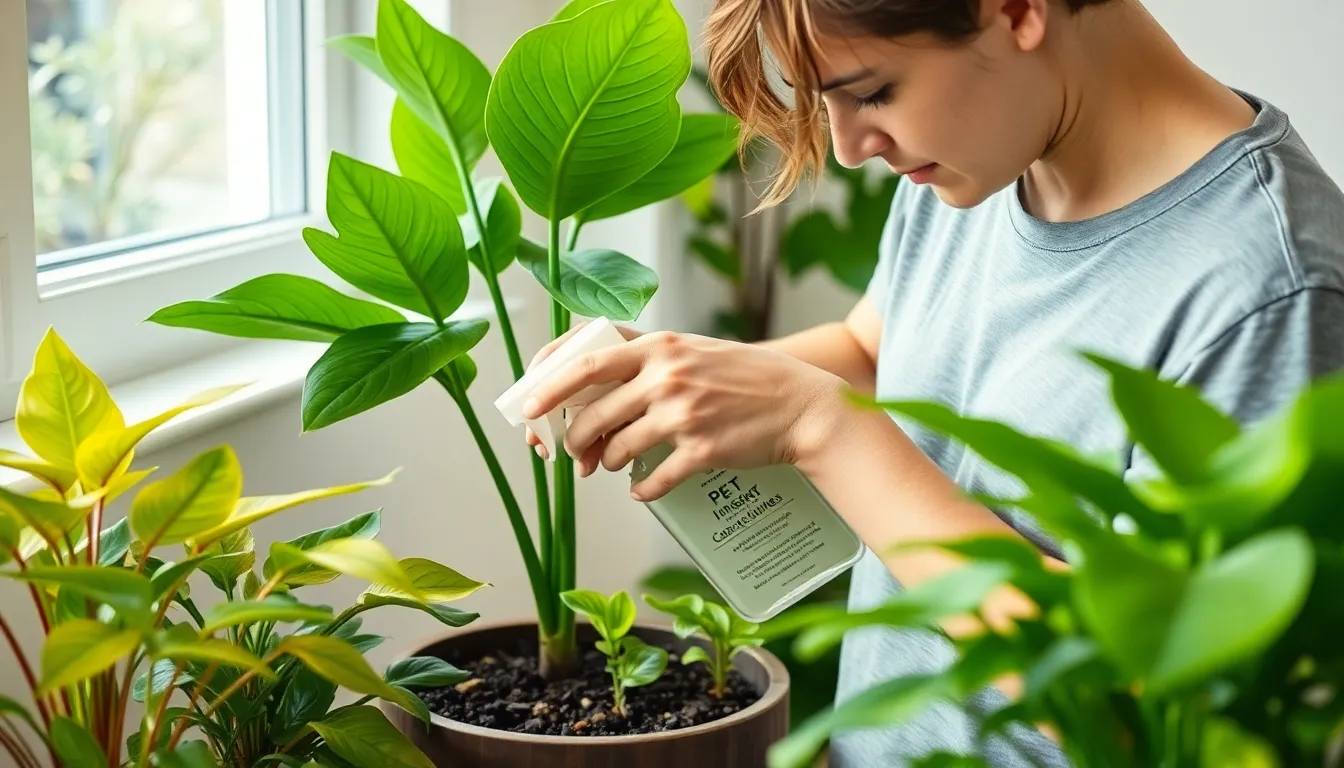
When natural remedies aren’t providing fast enough results, commercial products offer targeted answers that can eliminate gnat infestations more rapidly. These products are specifically formulated to tackle fungus gnats while maintaining the health of your houseplants.
Select Pet-Safe Insecticidal Sprays
Pet-safe insecticidal sprays designed for indoor plants provide an effective solution for households with furry family members. These sprays target both adult gnats and larvae without posing risks to pets who might come into contact with treated plants. Look for products labeled specifically as pet-safe or non-toxic to animals when shopping for gnat control answers.
Apply these sprays according to manufacturer instructions, focusing on the soil surface where gnats congregate and lay eggs. Many pet-safe formulations use plant-derived ingredients like neem oil or pyrethrin that effectively eliminate gnats while breaking down quickly to minimize environmental impact. We recommend testing the spray on a small area of each plant first to ensure compatibility with sensitive species.
Use Systemic Plant Treatments
Systemic plant treatments offer long-lasting protection by being absorbed directly into the plant’s vascular system. These treatments work from the inside out, killing gnats that feed on treated plants or their soil while providing weeks of ongoing protection. The systemic approach targets both larvae living in the soil and adult gnats that come into contact with the plant.
Apply systemic treatments by mixing them into the soil or watering them directly into the root zone according to package directions. These products reduce gnat populations by eliminating multiple generations at once, breaking the reproductive cycle more effectively than surface treatments alone. Systemic treatments typically show results within 7-14 days and continue working for 4-8 weeks, making them ideal for severe infestations or as preventive measures for valuable plants.
Prevent Future Gnat Infestations
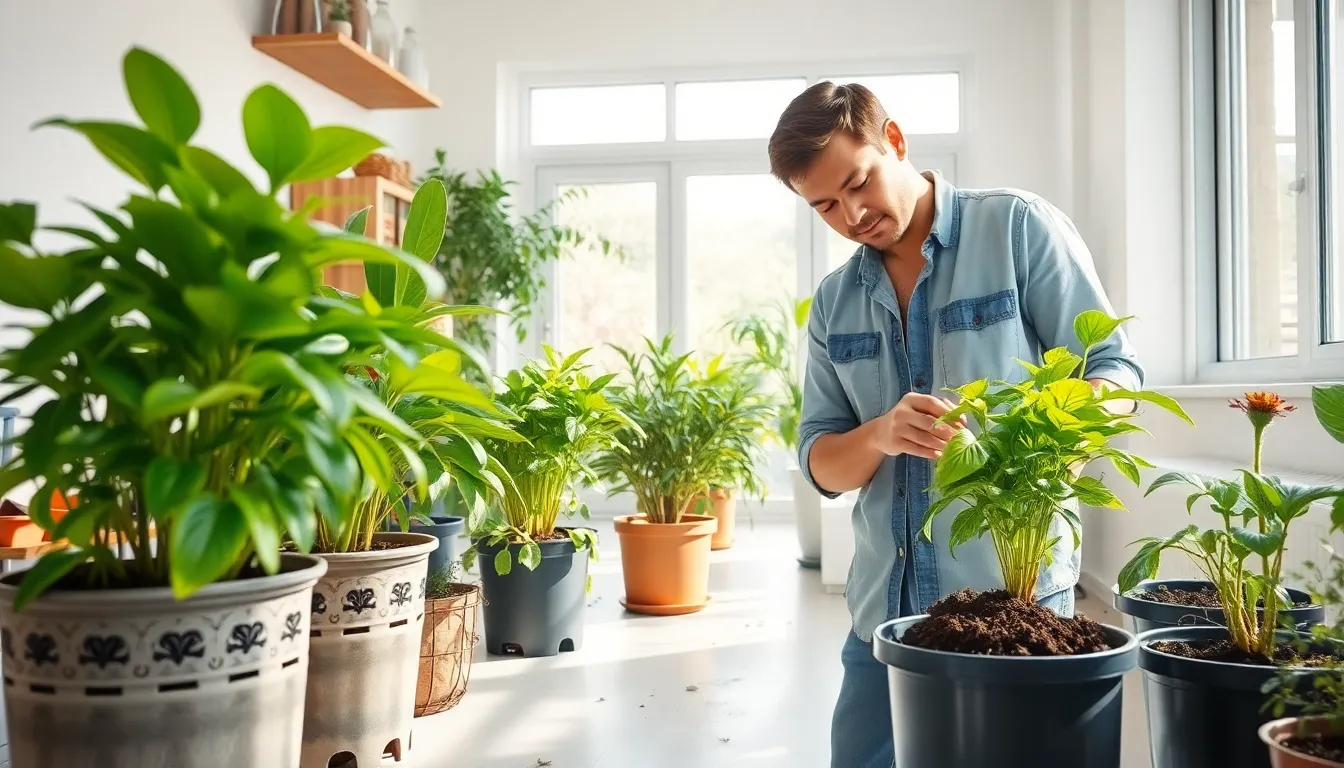
We’ve covered effective elimination methods, but preventing future infestations is equally important for maintaining healthy houseplants. Following these preventive measures will keep gnats away from our plants long term.
Establish Proper Watering Schedules
Watering only when the top inch of soil feels dry disrupts gnat breeding cycles completely. Fungus gnats thrive in consistently moist soil conditions, making overwatering the primary cause of infestations. We should check our plants’ soil moisture by inserting our finger about one inch deep before each watering session.
Providing adequate drainage prevents water from pooling at the bottom of containers. Excess water creates the perfect breeding environment for gnat larvae in stagnant conditions. We need to ensure our pots have proper drainage holes and remove any standing water from saucers within 30 minutes of watering.
Following species exact watering requirements reduces the risk of creating favorable gnat conditions. Different plants have varying moisture needs, and understanding these requirements helps us avoid the common mistake of uniform watering schedules. We should research each plant’s exact needs and group plants with similar watering requirements together for easier maintenance.
Quarantine New Plants Before Introduction
Isolating new plants for two to three weeks allows us to monitor for hidden pest problems. New plants from nurseries or garden centers often carry gnat eggs or larvae in their soil that aren’t immediately visible. We should place new acquisitions in a separate room or area away from our established plant collection during this observation period.
Inspecting quarantined plants daily helps us identify early signs of gnat activity. During the isolation period, we need to watch for flying adults near the soil surface, tiny larvae in the potting mix, or any unusual soil conditions. We can gently disturb the soil surface to check for small white or translucent larvae that indicate an existing infestation.
Treating any discovered pest issues before plant integration protects our entire collection. If we find signs of gnats during quarantine, we should apply appropriate treatment methods immediately. We can use hydrogen peroxide soil drenches or sticky traps to eliminate any pests before introducing the plant to our main growing area.
Maintain Clean Plant Care Tools
Cleaning pruning shears between plants prevents the transfer of gnat eggs and larvae. Contaminated tools can spread infestations from one plant to another, especially when we trim roots or work with soil. We should wipe our tools with rubbing alcohol or a diluted bleach solution after each use.
Washing watering devices regularly eliminates organic buildup that attracts gnats. Watering cans, spray bottles, and hoses can harbor organic matter in their reservoirs or nozzles. We need to clean these tools weekly with mild soap and water, ensuring no organic residue remains that could attract pests.
Sanitizing pots and containers before reuse removes potential gnat breeding sites. Previously used containers may contain gnat eggs or organic matter in their porous surfaces or drainage areas. We should scrub pots with a 10% bleach solution and rinse thoroughly before adding fresh soil and new plants.
Using sterile potting mix reduces the likelihood of introducing gnat problems through contaminated soil. Commercial sterile soil contains less organic material that attracts gnats compared to garden soil or homemade mixes. We should choose high quality potting mixes from reputable manufacturers and store unused soil in sealed containers to prevent contamination.
Conclusion
Taking control of gnat infestations in our houseplants doesn’t have to be overwhelming. With the right combination of moisture management natural remedies and preventive measures we can create an environment where our plants thrive while keeping these pesky insects at bay.
Remember that consistency is key when implementing these strategies. Whether we’re using apple cider vinegar traps adjusting our watering schedules or introducing beneficial nematodes regular monitoring and maintenance will ensure long-term success.
The investment we make in proper plant care today saves us from dealing with larger infestations tomorrow. By following these proven methods we’re not just eliminating current gnat problems – we’re building healthier growing conditions that benefit both our plants and our indoor gardening experience.
Frequently Asked Questions
What are fungus gnats and how do they differ from fruit flies?
Fungus gnats are small, dark-colored pests that hover around soil surfaces and damage plant root systems. Fruit flies are yellowish and attracted to overripe fruit and sugary substances. Fungus gnats breed in moist soil, while fruit flies prefer decaying organic matter. Identifying the correct pest is crucial for choosing effective treatment methods.
What are the main signs of a fungus gnat infestation?
Key signs include adult gnats flying around plants, tiny larvae visible in the soil, yellowing or wilting leaves, and fungal growth on soil surfaces. These indicators suggest gnat larvae are damaging the root system, leading to stunted plant growth and overall plant stress.
How does overwatering contribute to fungus gnat problems?
Overwatering creates ideal breeding conditions for fungus gnats by providing the moist environment they need to reproduce. Excess moisture in soil allows larvae to thrive and multiply rapidly. Allow the top 2 centimeters of soil to dry completely between waterings to disrupt their lifecycle.
What natural remedies effectively eliminate fungus gnats?
Apple cider vinegar traps with a drop of dish soap attract and catch adult gnats. Soap and water solutions sprayed on plants suffocate gnats without harming plants. Sprinkling cinnamon on soil surfaces disrupts larvae food sources with its antifungal properties. Regular application maintains control over populations.
How do yellow sticky traps work against fungus gnats?
Yellow sticky traps attract and catch adult gnats, disrupting their breeding cycle. Place traps near affected plants at soil level where gnats are most active. The bright yellow color mimics flowers, drawing gnats to the adhesive surface where they become trapped and die.
When should I repot plants affected by fungus gnats?
Repot when infestations are severe or other methods haven’t worked effectively. Use fresh, well-draining potting mix to eliminate existing larvae and eggs. Clean plant roots thoroughly, removing old soil and inspecting for damage before placing in new soil mix.
What are beneficial nematodes and how do they control gnats?
Beneficial nematodes (Steinernema feltiae) are microscopic roundworms that target gnat larvae in soil. Applied as a soil drench, they enter larvae and release bacteria that kill them from within. This biological control method is environmentally friendly and safe for plants and humans.
How does BTI (Bacillus thuringiensis israelensis) work against fungus gnats?
BTI is a naturally occurring bacterium that specifically targets gnat larvae while remaining safe for plants and humans. It requires repeated applications as adult gnats continue laying eggs. BTI disrupts the larvae’s digestive system, effectively breaking the reproductive cycle when applied consistently.
What preventive measures help avoid future fungus gnat infestations?
Establish proper watering schedules by watering only when the top inch of soil feels dry. Quarantine new plants for 2-3 weeks to monitor for pests. Use sterile potting mix and maintain clean plant care tools. Ensure adequate drainage in all plant containers to prevent moisture buildup.
Are commercial gnat control products safe for pets?
Many commercial products are specifically formulated to be pet-safe, containing plant-derived ingredients like neem oil or pyrethrin. Always read product labels carefully and choose products explicitly labeled as pet-safe. Systemic treatments absorbed by plants provide long-lasting protection without surface residue concerns.

